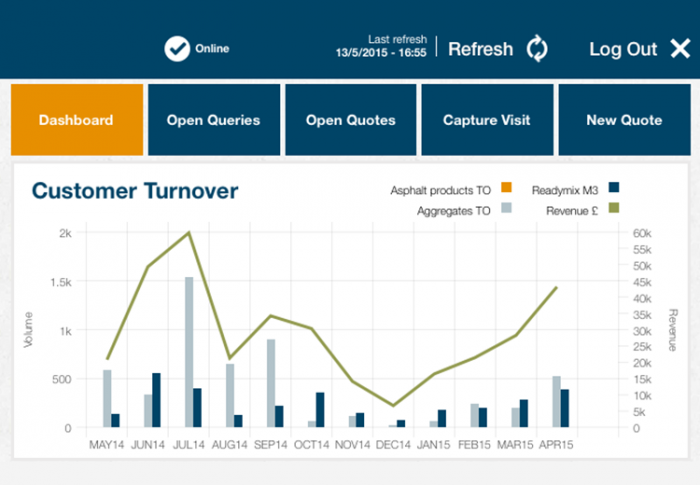Business today runs on tech. From a local mom-and-pop to Exxon Mobil, no matter what you sell, technology is going to be a big part of what you do and how you work.
And the driving force behind a recent surge in enterprise app development is that more and more of the workforce is working remotely and needs information at their fingertips.
What is an enterprise app?
An enterprise app is an application developed to boost work efficiency, make tasks simpler, integrate workflow more readily, and allow for smoother organizational operations.
Companies and workplaces are increasingly working to launch mobility initiatives that allow employees to be better connected to the company and one another through their devices.
Mobile apps are helping to close that gap at the enterprise level.
How your business can successfully leverage an enterprise app
Businesses are interested in enterprise apps for the efficiencies they can achieve. And those efficiencies can generally be broken down into three categories:
- Increasing overall productivity (e.g. simplifying admin processes).
- Empowering remote workers with more information and better connection to home base.
- Better data gathering, application, and access.
Most business cases can be broken down into one of these categories. It’s either going to make someone more productive, give remote workers more control, or improve access to relevant data.
Getting more specific, here are some ways that an enterprise app can help your business:
Internal Communication
Tasks in the workplace require efficient communication, coordination, scheduling and efficiency.
There have been countless workflow methodologies and management systems to streamline tasks and get results, such as the Getting Things Done system and Scrum, which are very helpful on their own. But internal enterprise apps can supplement these systems, encapsulating workflow communication, tasks, scheduling and more, into a portable and easily accessible app that everyone on the team can refer to without leaving their desks.
Imagine the core mechanics and advantages of streamlined workflow methodologies, available to your workers for constant reference and use in the form of an iPad application, allowing quick peer-to-peer communication in the form of something like a chat client with multiple channels.
Document Management
Documents such as schedules, spreadsheets, workflow charts, code, and others are constantly updated throughout a project’s cycle. An enterprise app can be used to share and manage documents and notify users of updates in real-time via push notifications.
You would be able to append a document and have that change instantly synchronized with your team members as it happens, and ensure they’re notified of it. A document could be transferred from the “In Progress” to “Complete” categories within the app, visualizing work being done as it happens.
Offline Access to Content
While most organizations have moved at least some of their processes to the web, this data can only be accessed when a user has an internet connection. With a custom-built iPad or tablet app, content can be configured to sync at regular intervals, or on demand, to ensure that employees can retrieve their files, or log relevant information, regardless of whether they have internet connection.
Preemptive Problem Prevention
Imagine a situation in which an employee finishes transcribing a handwritten office memo, submits it to the central document, but makes an error somewhere.
Traditionally, this can be cause for a lot of backtracking, logistical issues, and wasted time. An internally developed tablet app could be made with this in mind, allowing real-time data entry, allowing for instant transcription of notes and memos with no memory lapse or misread hand-writing.
This could then be instantly pushed out to everybody working on the project, so everybody is on the same page at the same time.
With everybody updated on each of their personal devices, an internal enterprise app can catch problems before they arise.
Removing the Middle Man
No longer would employees have to physically travel to the office, waste precious time, and get sidetracked by delivering information from one person to another. Administration is left up to the application, and not for the employees. This allows focus more on the task at hand, and not communicating the task at hand to others.
Everything Integrated
Cue-cards, calendars, “Done” and “To-Be-Completed” lists, memos, customer-survey forms – all of these can be necessary for a smooth workflow. However, they can also be disorganized, confusing and prone to being lost.
Imagine an iPad app that takes an all-in-one approach and is integrated with a complete system, separated by virtual “cards” or “tabs” for easy switching between each category. This saves a lot of grief, clears out a lot of confusion, and saves a lot of paper.
These are just some of the benefits of using a custom enterprise app, and we’re just scratching the surface.
Whether you’re a large corporation or a small startup, an business app created specifically for your workplace’s needs can streamline workflow, communication and problem solving, allowing an “always on” connection between employees.

Why enterprises should improve their internal systems
In the age of slick consumer apps that receive weekly updates, the image of enterprise apps as clunky, unsophisticated, expensive follies of development persists.
Enterprise-level software and internal systems in particular are prone to poor user experiences, compatibility problems, spreadsheet-like UI density, and poor data access – all of which create inefficiencies.
The prevailing logic to justify poor design for years has been that they have a fixed user base, and so less energy needs to be spent on making a great product.
After all, why spend the time to make something incredible when you know people have no other choice but to use it?
However, this trend is changing as enterprise internal systems are increasingly looking at their more polished consumer counterparts for inspiration, and as the ROI of these systems becomes more valuable.
Here are ways that good internal systems actually save money.
Efficient Systems Save Time
Time is money, and poor internal systems take longer to use. Enterprise organizations need to be asking themselves if their internal systems are helping employees be as efficient as possible. The challenge is, the team implementing new software isn’t made up of the same people who are going to be using it. End-user consultation will pretty quickly reveal inefficiencies.
For example, imagine an over-the-phone sales person selling refrigerators. For every completed sale, they need to capture a range of information from the customer, including:
- Customer address
- Customer credit card information
- Model that the customer wanted
- Transportation option selected
The longer the information takes to enter, the longer each sale takes, and the more downtime each sales rep has, and the less sales they make. Even a minor tweak, like making it easier to move between fields, can speed the sales process.
Better systems make for better data
Companies today face a paradoxical challenge – while they have more information than ever before, they’re increasingly unable to turn it into useful insights. Basically, useful data tends to get lost in the noise.
Poor internal systems tend to collect, but lack any analysis. A better design and an enhanced UI lets key staff access the data they need when they need it, quickly and effectively. Imagine a sales team that has instant access to a customer’s entire sales history rather than having to go and collate it or (worse) ask the customer what they’ve purchased in the past.
Improved Customer Experience
Customers are increasingly less tolerant of poor experiences. Inadequate internal systems strain customer-facing staff within large organizations. On the flipside, internal systems that are designed and implemented with the end-user in mind make the staff’s lives easier, and that bleed through to the consumers. And aside from the ethereal tone of CX, improved internal systems speed any customer interaction.
Think of the internal systems like oil in a car: they help every single interaction and are key to providing a smooth ride.
For example, imagine a customer returning a product. There’s a lot of information to sort through. The better the system, the faster the transaction and the happier the customer. And happy customers are generous customers.
Examples of enterprise apps that improve organizational efficiency
Let's look at three examples of companies who have done it right.
Basic hypothetical
Here’s a basic hypothetical business case for an enterprise mobile app:
Imagine you are a company that has many employees in the field, such as a residential plumbing company.
Your operations are set up so that each plumber goes to the house, does the job, completes the paperwork in their truck, and turns it in at the end of every day to the head office. The next morning, they head out on new jobs and head office processes the paperwork from the previous day.
It’s not a bad system. It’s just not a great one.
What if:
- The plumber misplaces the paperwork? No invoice means time wasted with admin chasing it up.
- What if the plumber makes a mistake? After all, a truck is not really a place to fill in complicated forms.
- What if a new job comes in and the plumber needs to rush away? The paperwork might not be completed at the time, leading to overtime and a backlogged head office.
All these problems are things that happen virtually every day to companies with employees in the field. It’s no one’s fault – it’s just that it’s a complicated system with many steps and thus mistakes happen.
An enterprise app can help solve those problems.
Instead of filing paperwork from a truck, the plumber is able to use his or her phone or tablet to log time and complete the worksheet. The data is automatically made available to head office, who now have much more time to process an invoice and send it to the customer.
If they spot a problem or there’s a dispute, the plumber may very well still be on the scene to sort it out. All this reduces time spent on admin, which means more time spent on clients, which means more money coming in, which means a better bottom line.
So that’s a rough business case for an enterprise app. Making accurate data more readily available, and making a workforce more efficient. There are many different manifestations, but that’s the general idea.
But does it actually happen?As it turns out, yes, it really does.
Here are three examples from real companies that prove enterprise app development is worth the money.
Hanson UK

Hanson UK is a cement company. They make cement and deliver it to various clients. They decided to develop an enterprise mobile app for two reasons:
- To improve the flow of information from frontline workers back to district and area managers.
- To streamline the quotes process for new customers.
They had a custom app built that would allow, among other things, their district managers to respond to invoice disputes faster.
Like our hypothetical case above, the old system relied on drivers taking the invoice, returning it to head office, head office sending it out, the customer disputing it, and then management getting involved.
Now, whenever an invoice is disputed, it’s uploaded straight to the app. Suddenly, a manager can call a customer moments after they’ve disputed an invoice and find out what’s going on. It’s vastly more efficient and provides significantly better customer service.
The app is also designed to help new customers. It has a live quote option, so sales teams can provide comprehensive, accurate quotes on the spot, since it enables access to the full range of products and services Hanson UK offers. Basically, it’s like carrying around a company inventory manual in your pocket.
Hanson was finding that most of its invoice disputes were being caused by badly quoted projects via the sales team. Now, with more information out there, the sales team can provide better quotes and streamline the process.
That small feature is expected to improve working capital by 7%, which is a giant increase.
Fence Outlet
Fence Outlet is a fencing company in Florida. It was experiencing a similar problem as most field service organizations – sales happen in the field, and it’s hard to get the information to the sales team as they need it.
To make matters worse, Fence Outlet priced their product based on sophisticated pricing algorithms, which are great for running a thin margin but terrible to work out on the fly.
The result was that, in addition to being slow, their paperwork and proposal process was extremely error prone. Until they got an app.
Their iPad app enables contractors to work out on the spot how much a fence is going to cost. All they have to do is enter a few variables and the business app does the rest.
So the contractor selects the material, length, style, what part of Florida it’s in (for sales tax purposes), and how long it’s going to take, and – voila! Accurate pricing, just like that.
With this app, it’s easier for contractors or sales people to go out and give accurate, detailed proposals quickly and efficiently, and the information is stored locally when the device is offline, until it can go back online and sync with the server.
That way, a fencing sales person can inspect a property, come up with a quote, and sign the client – all without WiFi – and that information is uploaded and processed to the organization at large at a later day automatically.
Ottawa Hospital
Ottawa Hospital is a busy teaching hospital, where occupancy regularly exceeds 110%. They turned towards mobile solutions to help handle the inevitable backlog of patients and errors.
What’s more, hospitals are complicated operations, and there may be half a dozen specialists who all need a single patient’s chart. It’s hard to quickly share information to every team member who needs it.

In order to improve patient care and reduce healthcare costs, Ottawa Hospital restructured its operations to be mobile, and is embracing mHealth with multiple apps for different functions.
But one of their first was the clinical mobile app, or CMA.
The CMA is an iPad app designed to do three things:
- Access information
- Display visual test results (e.g. X-rays, CT scans)
- Order tests and prescriptions
The CMA enables doctors to stay up to date with their patients faster and more readily than before. Previously, they would have to spend hours reviewing cases before seeing patients just to get up to speed. With the CMA, they don’t have to do that anymore.
In addition to time savings (and therefore bottom line savings), the CMA allows physicians to spend more time with each patient, instead of running to and from a computer to check stats, progress reports, or results.
Final thoughts
From hospitals to field service companies to cement companies, there are many different ways for enterprise apps to save an organization money.
What it boils down to is that we are on the cusp of an era defined by a mobile workforce, not a cubicle. Enterprise companies stand to save huge by investing now.
Forward thinking companies are already investing in mobile solutions. It’s time everyone else got on board.
